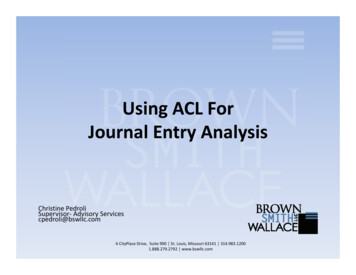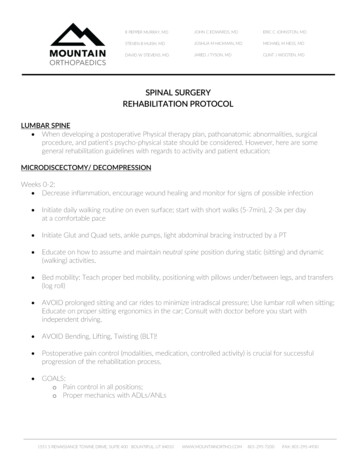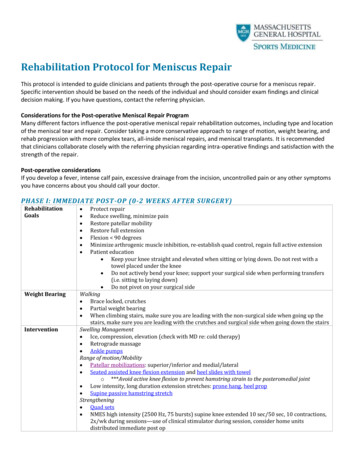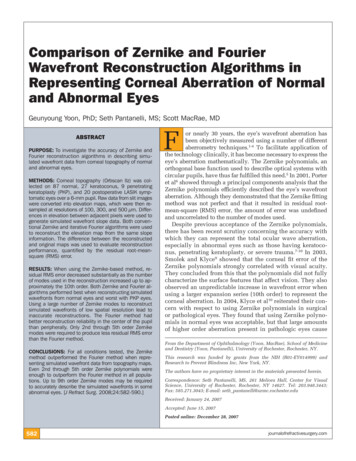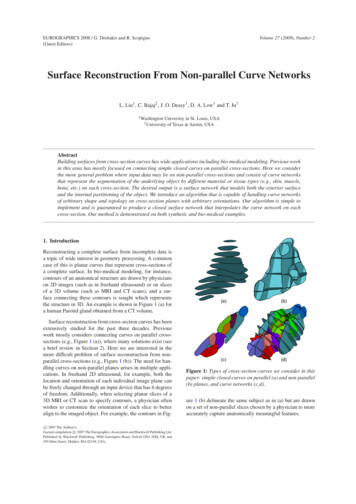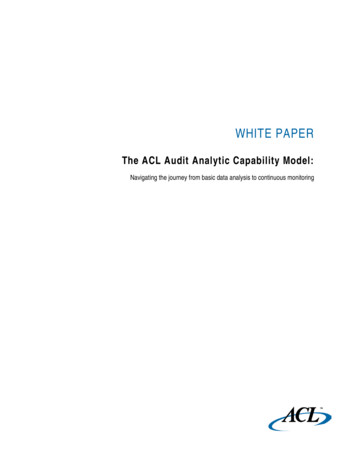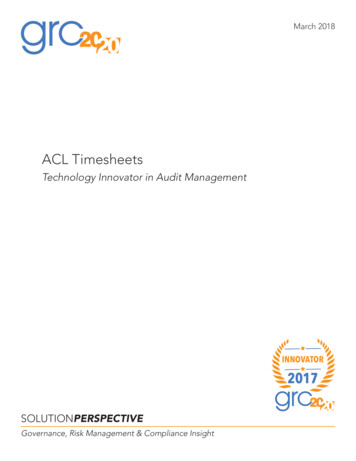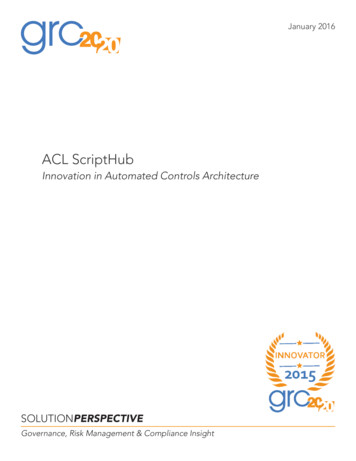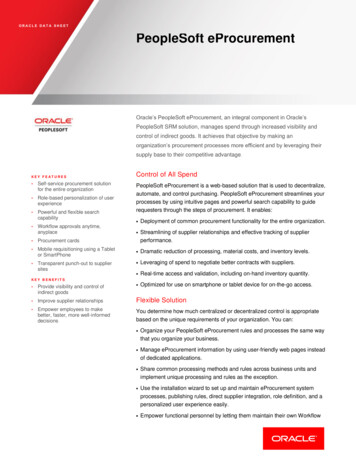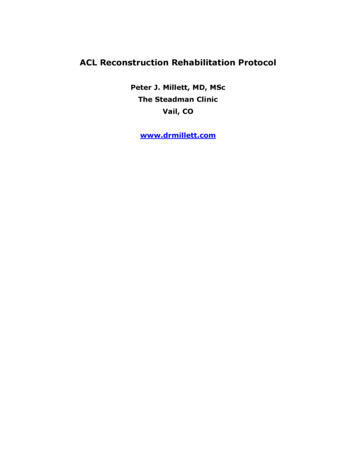
Transcription
ACL Reconstruction Rehabilitation ProtocolPeter J. Millett, MD, MScThe Steadman ClinicVail, COwww.drmillett.com
ACL Reconstruction Rehabilitation ProtocolTable of ContentsPreoperative Rehabilitation Phase.3Understanding Surgery .7Postoperative Days 1 - 7 .8Postoperative Days 8 - 10 . 12Postoperative Week 2 . 13Postoperative Weeks 3 - 4. 16Postoperative Weeks 4 - 6. 17Postoperative Weeks 6 – 12 . 17Postoperative Weeks 12 – 20. 1824 Weeks Postoperative (6 months) . 18Medication Regimen . 18List of FiguresFigure 1.Heel prop using a rolled towel. .4Figure 2.Prone Hang. Note the knee is off the edge of the table. .4Figure 3.Wall Slide: Allow the knee to gently slide down.5Figure 4.Heel slide – leg is pulled toward the buttocks .5Figure 5.Heel slides in later stages of rehabilitation .5Figure 6.Stationary Bicycle helps to increase strength.6Figure 7.Use the non-injured leg to straighten the knee . 10Figure 8.Passive Flexion allowing gravity to bend the knee to 90 degrees . 10Figure 9.Straight leg raises – lying (left) and seated (right) . 11Figure 10.Partial squat using Table for stabilization . 13Figure 11.Toe Raise . 14Figure 12.Leg press using 90-0 degree range . 16-2-
Peter J. Millett, MD, MScSports Medicine and Orthopaedic SurgeryACL Reconstruction Rehabilitation ProtocolOne of the most common complications following ACL reconstruction is loss of motion,especially loss of extension. Loss of knee extension has been shown to result in a limp,quadriceps muscle weakness, and anterior knee pain. Studies have demonstrated that thetiming of ACL surgery has a significant influence on the development of postoperative kneestiffness.THEHIGHEST INCIDENCE OF KNEE STIFFNESS OCCURS IFACLSURGERY IS PERFORMEDWHEN THE KNEE IS SWOLLEN, PAINFUL, AND HAS A LIMITED RANGE OF MOTION.The risk of developing a stiff knee after surgery can be significantly reduced if the surgery isdelayed until the acute inflammatory phase has passed, the swelling has subsided, a normalor near normal range of motion (especially extension) has been obtained, and a normal gaitpattern has been reestablished.Preoperative Rehabilitation PhasePrepare for surgery using the information within this section.Goals:****Control pain and swellingRestore normal range of motionDevelop muscle strength sufficient for normal gait and ADLMentally prepare the patient for surgeryBefore proceeding with surgery the acutely injured knee should be in a quiescent state withlittle or no swelling, have a full range of motion, and the patient should have a normal ornear normal gait pattern.More important than a predetermined time before performing surgery is the condition of theknee at the time of surgery. Use the following guidelines to prepare the knee for surgery:Immobilize the kneeFollowing the acute injury you should use a knee immobilizer and crutches until you regaingood muscular control of the leg. Extended use of the knee immobilizer should be limited toavoid quadriceps atrophy. You are encouraged to bear as much weight on the leg as iscomfortable.Control Pain and SwellingIcing along with nonsteroidal anti-inflammatory medications such as Advil, Nuprin, Motrin,Ibuprofen, Aleve (2 tablets twice a day) are used to help control pain and swelling. Thenonsteroidal anti-inflammatory medications are continued for 7 - 10 days following theacute injury.-3-
ACL Reconstruction Rehabilitation ProtocolRestore normal range of motionYou should attempt to achieve full range of motion as quickly as possible. Quadricepsisometrics exercises, straight leg raises, and range of motion exercises should be startedimmediately.Full extension is obtained by doing the following exercises:1) Passive knee extension. Sit in a chair and place your heel on the edge of a stool or chair. Relax the thigh muscles. Let the knee sag under it's own weight until maximum extension is achieved.2) Heel Props: Place the heel on a rolled towel making sure the heel is propped high enough tolift the thigh off the table. Allow the leg to relax into extension. 3 - 4 times a day for 10 - 15 minutes at a time. See Figure 1Figure 1. Heel prop using a rolled towel.3) Prone hang exercise. Lie face down on a table with the legs hanging off the edge of the table. Allow the legs to sag into full extension.Figure 2. Prone Hang. Note the knee is off the edge of the table.-4-
Peter J. Millett, MD, MScSports Medicine and Orthopaedic SurgeryBending (Flexion) is obtained by doing the following exercises:1) Passive knee bend Sit on the edge of a table and let the knee bend under the influence of gravity.2) Wall slides are used to further increase bending. Lie on the back with the involved foot on the wall and allow the foot to slide downthe wall by bending the knee. Use other leg to apply pressure downward.Figure 3. Wall Slide: Allow the knee to gently slide down3) Heel slides are used to gain final degrees of flexion. Pull the heel toward the buttocks, flexing the knee. Hold for 5 seconds. Straighten the leg by sliding the heel downward and hold for 5 seconds.Figure 4. Heel slide – leg is pulled toward the buttocks In later stages of rehabilitation, do heel slides by grasping the leg with bothhands and pulling the heel toward the buttocks.Figure 5. Heel slides in later stages of rehabilitation-5-
ACL Reconstruction Rehabilitation ProtocolDevelop muscle strengthOnce 100 degrees of flexion (bending) has been achieved you may begin to work onmuscular strength:1) Stationary Bicycle. Use a stationary bicycle two times a day for 10 - 20 minutes to helpincrease muscular strength, endurance, and maintain range of motion. See Figure 6Figure 6. Stationary Bicycle helps to increase strength2) Swimming is also another exercise that can be done during this phase to develop musclestrength and maintain your range of motion.3) Low impact exercise machines such as an elliptical cross-trainer, leg press machine, legcurl machine, and treadmill can also be used.This program should continue until you have achieved a full range of motion and goodmuscular control of the leg (you should be able to walk without a limp).Mentally prepare Understand what to realistically expect of the surgery Make arrangements with a physical therapist for post-operative rehabilitation Make arrangements with your place of employment. Make arrangements with family and/or friends to help during the post-operativerehabilitation Read and understand the rehabilitation phases after surgery-6-
Peter J. Millett, MD, MScSports Medicine and Orthopaedic SurgeryUnderstanding SurgeryThis section provides an understanding of the pre and post-operative phases of surgery.Key terms:Pain control, Drainage tube, Cryocuff, Knee Immobilizer, TEDStockingBefore SurgeryPrior to beginning the operation and at the conclusion of the operation, a solution containinga long acting local anesthetic Marcaine will be injected into your knee. This solution willblock the pain nerve fibers and local pain receptors in your knee. Recent studies haveshown that this is a safe and effective way to control pain after knee surgery. In manycases the injection will last 12 or more hours after surgery and significantly reduce theamount of pain medication that you will have to take.After SurgeryPrior to leaving the operating room a knee immobilizer and an ice machine will be applied toyour knee. The GameReady ice machine will provide cold and compression, reducing painand swelling. This unit should be used continuously for the first 3 - 4 days afteryour surgery. After this time period the Game Ready can be used as needed forcomfort. The Game Ready should be used for approximately 30 minutes, with 30minutes between sessions. The postoperative knee brace helps to maintain extension and is to be worn at alltimes while walking and during sleeping, Otherwise it can be removed. After surgery, your leg will be wrapped in soft cotton bandage. You can slide thebandage down to change the dressings as needed.After the anesthesia has worn off, your vital signs are stable and your pain is under controlyou will be discharged from the hospital or surgical center.You will not be allowed to drive a car. Therefore prior to your discharge, you must arrangefor transportation.-7-
ACL Reconstruction Rehabilitation ProtocolPostoperative Days 1 - 7Follow the guidelines within this section for the first seven days after your surgeryIT IS EXTREMELY IMPORTANT THAT YOU WORK ON EXTENSION IMMEDIATELY.Goals:******Control pain and swellingCare for the knee and dressingEarly range of motion exercisesAchieve and maintain full passive extensionPrevent shutdown of the quadriceps musclesGait trainingControl Pain and Swelling1) Control Swelling. Following discharge from the hospital you should go home elevate yourleg and keep the knee iced using the GameReady cooling unit. You may get up to usethe bathroom and eat, but otherwise you should rest with your leg elevated.2) Do not sit for long periods of time with your foot in a dependent position (lower than therest of your body), as this will cause increased swelling in your knee and leg. Whensitting for any significant period of time, elevate your leg and foot.3) Control Pain. You will be sent home with a prescription for a strong narcotic medication.You should take this for severe pain, as directed on the prescription bottle label.4) As your pain and swelling decrease you can start to move around more and spend moretime up on your crutches.-8-
Peter J. Millett, MD, MScSports Medicine and Orthopaedic SurgeryCaring for your knee1) The first night and day after the surgery you can expect the white elastic stocking andbandages to get bloody. This is normal! We want the blood to drain out of the knee onto the dressings rather than build-up in your knee and cause swelling and pain.If the dressings become extremely bloody or wet you should change or reinforce themas needed. Use the following directions for changing the dressing: The elastic stocking should be removed first followed by the cotton wrap and 4inch x 4 inch gauze bandages. A clean, dry, 4 inch x 4 inch gauze bandage should be applied over the incisionsand held in place a clean elastic dressing. Do not use tape to keep the gauze in place as this may cause skin blisters. Thestocking will keep the gauze in place.2) We recommend that you limit weight bearing to prevent swelling.3) You can start using a stationary bike. Cycling is an excellent conditioning and buildingexercise for the quadriceps. Start with the seat fairly high and use a short diameterpedal if available so that the knee doesn’t bend too much. At this early stage, youshould just “spin” without any resistance. Use your good leg to turn the pedal.4) You may shower, but you must keep your incisions dry for the first 7-10 days. This canbe achieved by placing a waterproof dressing or plastic bag over your leg.5) The sutures are absorbable and do not need to be removed.IT IS IMPORTANT TO KEEP THE INCISIONS DRY FOR THE FIRST 7-10 DAYS.6) A follow-up visit should be scheduled 2 weeks following the operation by contacting myoffice at (970) 479-5879.7) You may remove the knee brace while doing exercises or if you are in a safe, protectedenvironment. However, the knee immobilizer should be worn while sleeping for the first4 weeks, and at all times while you walk for the first 6 weeks.-9-
ACL Reconstruction Rehabilitation ProtocolEarly Range of Motion and Extension1) Passive extension of the knee by using a rolled towel. Note the towel must be highenough to raise the calf and thigh off the table. See Figure 1 on page 4. Remove the knee immobilizer from your knee every 2 - 3 hours while awake Position the heel on a pillow or rolled blanket with the knee unsupported Passively let the knee sag into full extension for 10 - 15 minutes. Relax yourmuscles, and gravity will cause the knee to sag into full extension.This exercise can also be done by sitting in a chair and supporting the heel on the edgeof a stool, table or another chair and letting the unsupported knee sag into fullextension.2) Active-assisted extension is performed by using the opposite leg and your quadricepsmuscles to straighten the knee from the 90 degree position to 0 degrees.Hyperextension should be avoided during this exercise. See Figure 7:Figure 7. Use the non-injured leg to straighten the knee3) Passive flexion (bending) of the knee to 90 degrees. (See Figure 8 below) Sit on the edge of a bed or table and letting gravity g
Pull the heel toward the buttocks, flexing the knee. Hold for 5 seconds. Straighten the leg by sliding the heel downward and hold for 5 seconds. Figure 4. Heel slide – leg is pulled toward the buttocks In later stages of rehabilitation, do heel slides by grasping the leg with both hands and pulling the heel toward the buttocks. Figure 5. Heel slides in later stages of .
